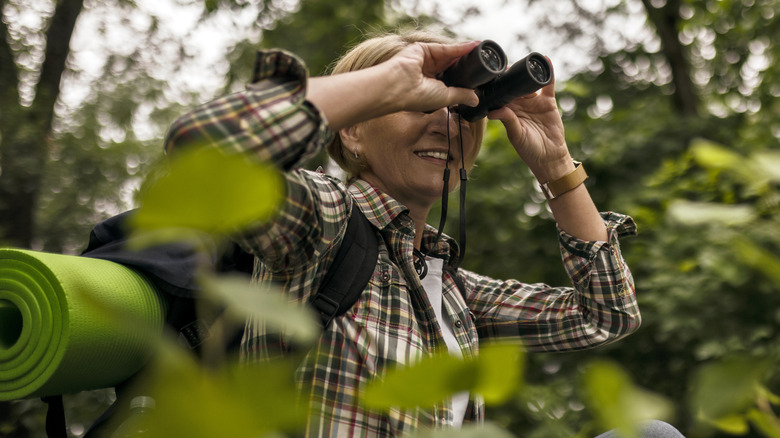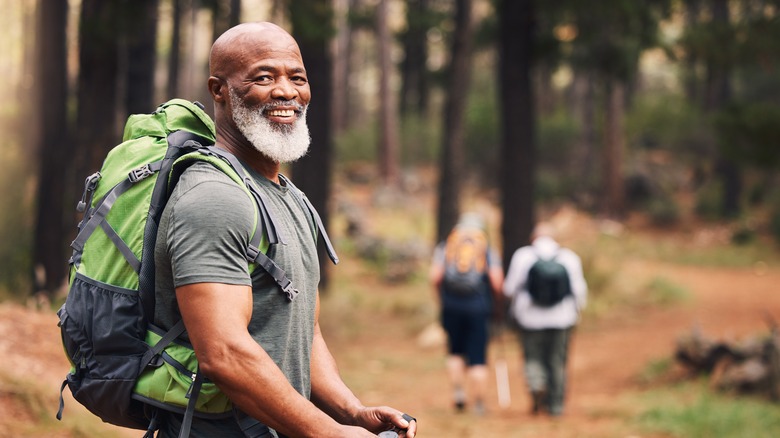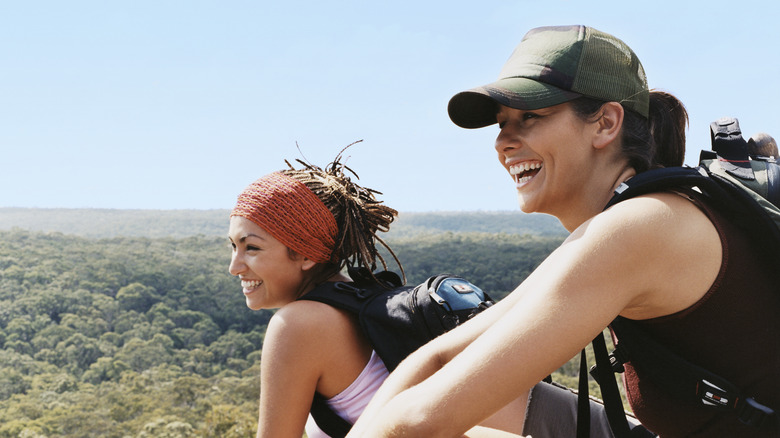How To Protect Yourself From Animals While Hiking
There's nothing like getting into the great outdoors. The views of nature are spectacular, and bucolic landscapes can give us fresh perspectives on life. Not to mention, a vigorous hike is a great way to get exercise and bond with friends and family.
But hiking can be an intense experience too. For starters, the odds of running into animals increase, and some unexpected encounters can be very dangerous. There's also legitimate concern about ticks, and the possibility of getting Lyme disease, or other diseases and fevers from a tick bite. Besides the threats from living creatures, hiking in and of itself can be dangerous. There's a trail at Zion National Park called Angels Landing that's one of the world's most dangerous trails. Meanwhile, Hawaii's most beautiful hiking trail, the Kalalau Trail, is also deadly. This isn't to dampen anyone's enthusiasm for lacing up the old boots and hitting the trail. It's just to be mindful of how awe-inspiring, but also lethal, Mother Nature can be, which is why it's wise to be conscientious about every aspect of hiking. This includes protecting yourself from animals.
Make some noise and hike in a group
While it might be appealing to seek out solitude in the great outdoors, one of the safest things hikers can do is make a bit of noise while walking a trail. This gives animals fair warning that you're coming and gives them a chance to walk away. This is one of the many reasons why it's safer to hike in pairs or in a group, as opposed to hiking alone. The National Park Service advises hikers to chat with fellow hikers, keep conversations animated, and even sing and clap their hands on the trail. It might seem silly, but it gives animals, especially bears, a heads-up. Bear bells aren't always loud enough to warn animals of oncoming hikers. It's still advisable to carry bear spray. This is useful not just for bear attacks, but with other aggressive mammals too. It can deter an attack without the lethal element of firearms.
It's wise to plan your hikes around downtime for animals. Most animals are active at dawn and dusk. Hey, this is true even for sharks, so think of the timing of your outdoor excursions as the surf-and-turf law of safety in the natural world. Hike in the middle of the day to avoid encounters with animals. If you do encounter an animal while hiking, give it as much room as possible. Keep an eye on the animal and back away slowly; move backward so that you can face the animal. Do not run.
Know where you're hiking
One of the best ways to stay safe while hiking is to be aware of what animals live in the terrain. Do some research ahead of time. Be aware of the time of year, and how that impacts the animal's habits. For example, bears emerge in the spring after hibernation and forage the most during the fall, so they'll be most active — and hungry — at those times. If you're in a rattlesnake region, ensure that you're wearing tall hiking boots and carrying a snake kit. Keep an eye out while hiking. Look for animal tracks and scat, and have a rough idea of how to identify these if you see them on the trail. Note any digging or claw marks on trees. This is a pretty good indication that you're in bear country.
It's also wise to hike on the marked trails. Don't veer off into uncharted territory. Michael Wald, who runs Arctic Wild, a guide service, explained to Outside that hikers don't need to be afraid of animals. Wald believes that humans and animals can coexist in a peaceful way, so long as humans are cognizant of what's going on around them. "If you understand and respect bears, you can avoid most problems with them," Wald explained. "Don't invade their space and surprise them, and don't give them a reason to be curious about you or your camp. Peaceful coexistence is achievable." The best course of action is cautious respect for the great outdoors, and a mindful, aware approach when hiking.


